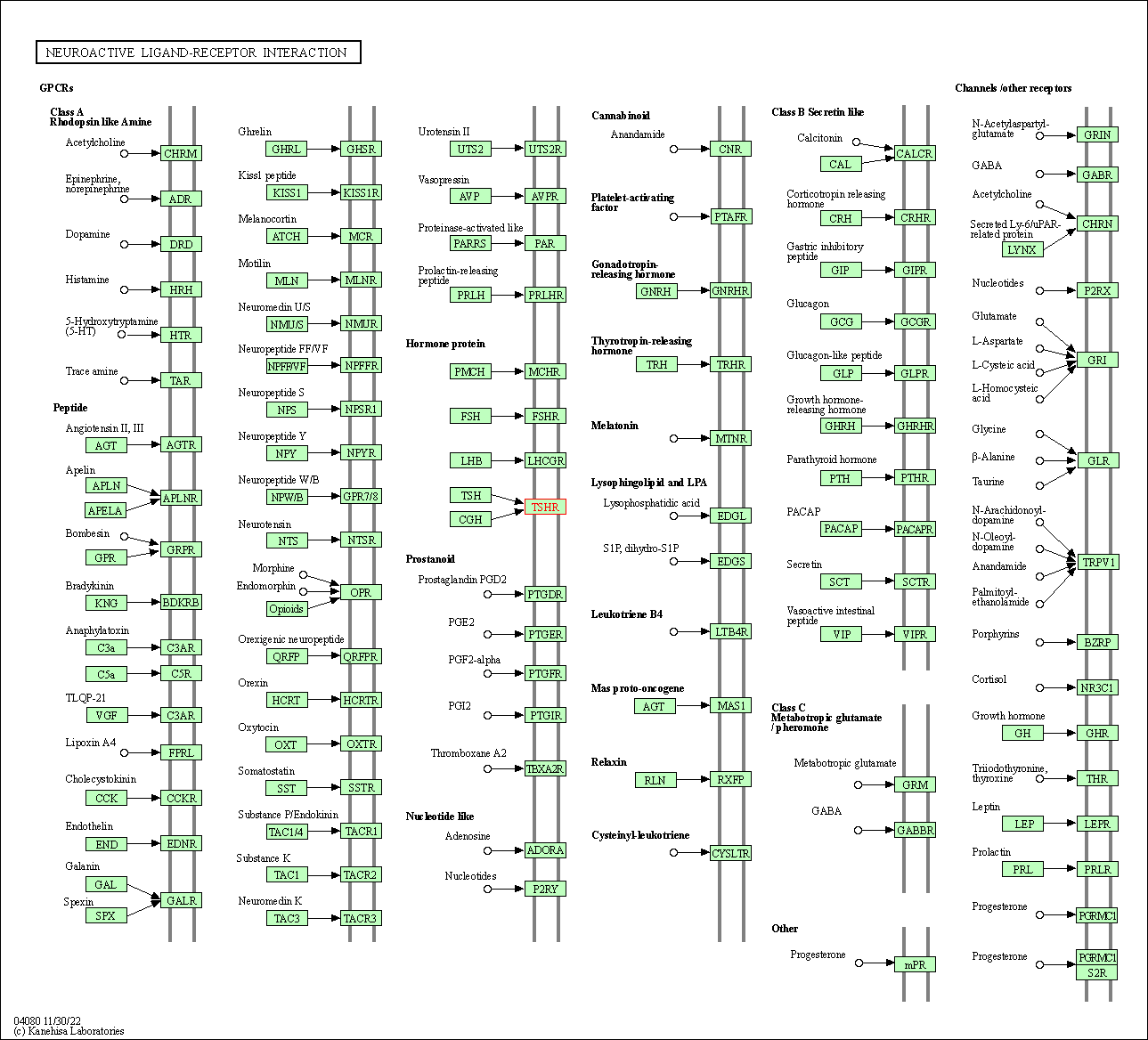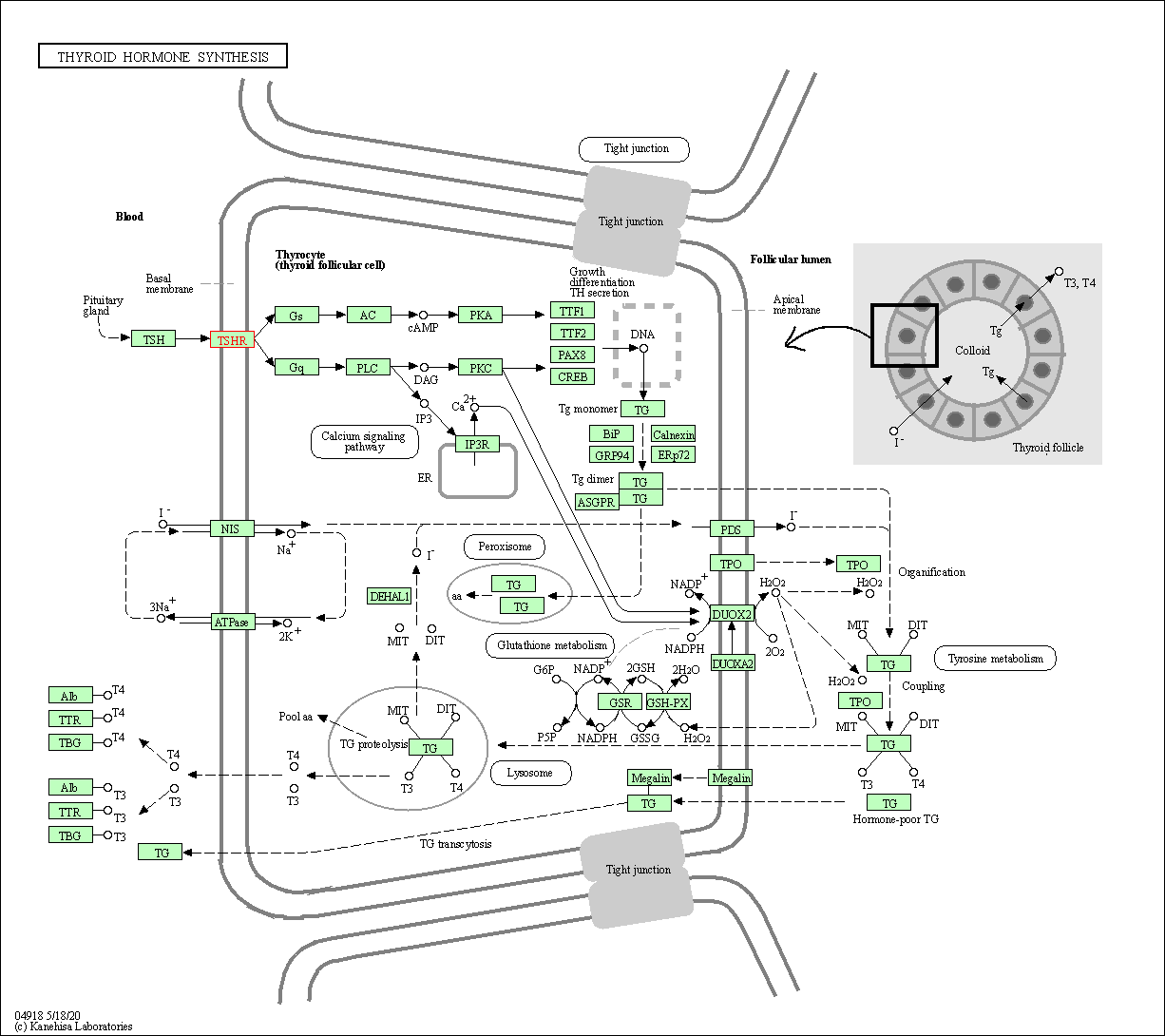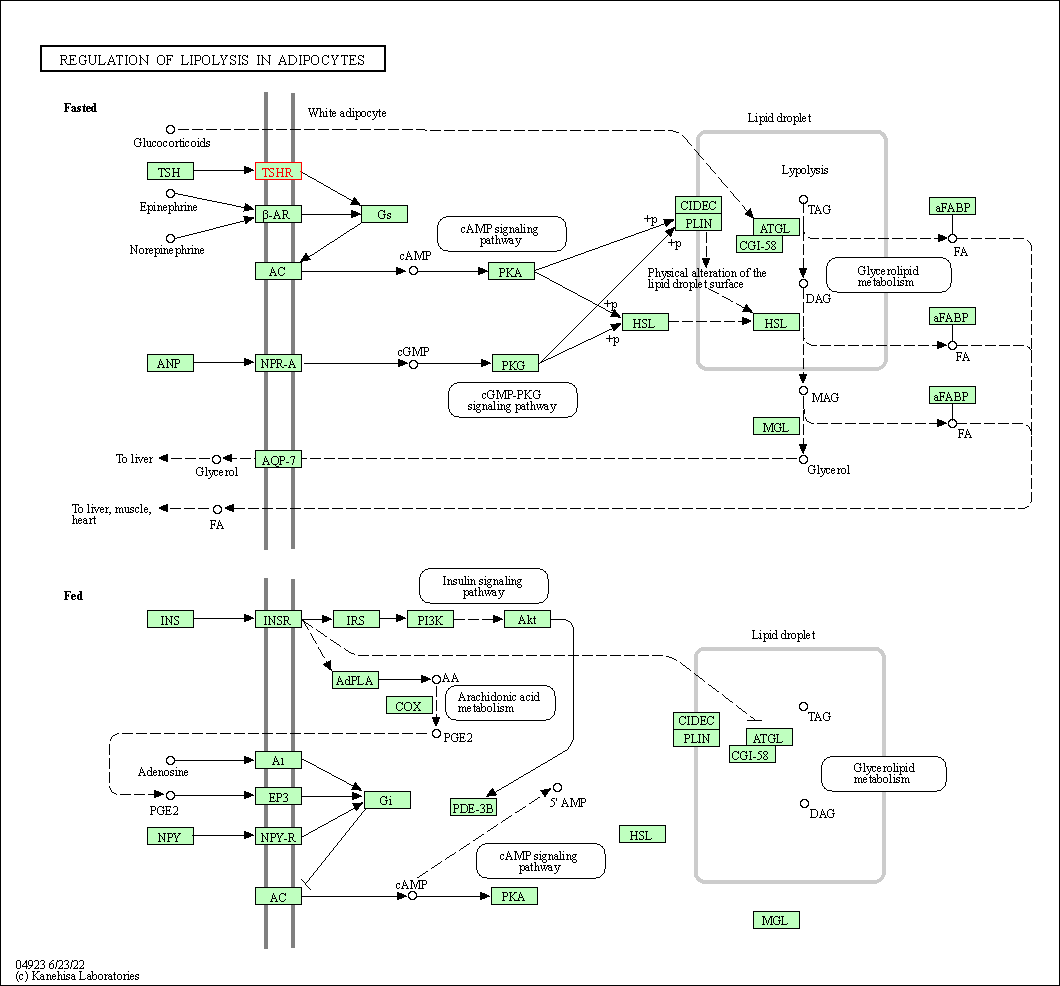Target Information
| Target General Information | Top | |||||
|---|---|---|---|---|---|---|
| Target ID |
T60606
(Former ID: TTDS00452)
|
|||||
| Target Name |
Thyrotropin receptor (TSHR)
|
|||||
| Synonyms |
Thyroid stimulating hormone receptor; TSHR; TSH-R; TSH receptor
Click to Show/Hide
|
|||||
| Gene Name |
TSHR
|
|||||
| Target Type |
Successful target
|
[1] | ||||
| Disease | [+] 2 Target-related Diseases | + | ||||
| 1 | Hypo-thyroidism [ICD-11: 5A00] | |||||
| 2 | Thyroid cancer [ICD-11: 2D10] | |||||
| Function |
Receptor for thyrothropin. Plays a central role in controlling thyroid cell metabolism. The activity of this receptor is mediated by G proteins which activate adenylate cyclase. Also acts as a receptor for thyrostimulin (gpa2+gpb5).
Click to Show/Hide
|
|||||
| BioChemical Class |
GPCR rhodopsin
|
|||||
| UniProt ID | ||||||
| Sequence |
MRPADLLQLVLLLDLPRDLGGMGCSSPPCECHQEEDFRVTCKDIQRIPSLPPSTQTLKLI
ETHLRTIPSHAFSNLPNISRIYVSIDVTLQQLESHSFYNLSKVTHIEIRNTRNLTYIDPD ALKELPLLKFLGIFNTGLKMFPDLTKVYSTDIFFILEITDNPYMTSIPVNAFQGLCNETL TLKLYNNGFTSVQGYAFNGTKLDAVYLNKNKYLTVIDKDAFGGVYSGPSLLDVSQTSVTA LPSKGLEHLKELIARNTWTLKKLPLSLSFLHLTRADLSYPSHCCAFKNQKKIRGILESLM CNESSMQSLRQRKSVNALNSPLHQEYEENLGDSIVGYKEKSKFQDTHNNAHYYVFFEEQE DEIIGFGQELKNPQEETLQAFDSHYDYTICGDSEDMVCTPKSDEFNPCEDIMGYKFLRIV VWFVSLLALLGNVFVLLILLTSHYKLNVPRFLMCNLAFADFCMGMYLLLIASVDLYTHSE YYNHAIDWQTGPGCNTAGFFTVFASELSVYTLTVITLERWYAITFAMRLDRKIRLRHACA IMVGGWVCCFLLALLPLVGISSYAKVSICLPMDTETPLALAYIVFVLTLNIVAFVIVCCC YVKIYITVRNPQYNPGDKDTKIAKRMAVLIFTDFICMAPISFYALSAILNKPLITVSNSK ILLVLFYPLNSCANPFLYAIFTKAFQRDVFILLSKFGICKRQAQAYRGQRVPPKNSTDIQ VQKVTHDMRQGLHNMEDVYELIENSHLTPKKQGQISEEYMQTVL Click to Show/Hide
|
|||||
| 3D Structure | Click to Show 3D Structure of This Target | AlphaFold | ||||
| HIT2.0 ID | T15YX5 | |||||
| Drugs and Modes of Action | Top | |||||
|---|---|---|---|---|---|---|
| Approved Drug(s) | [+] 2 Approved Drugs | + | ||||
| 1 | Thyrotropin | Drug Info | Approved | Hypothyroidism | [2] | |
| 2 | Thyrotropin Alfa | Drug Info | Approved | Thyroid cancer | [3] | |
| Mode of Action | [+] 3 Modes of Action | + | ||||
| Modulator | [+] 1 Modulator drugs | + | ||||
| 1 | Thyrotropin | Drug Info | [4] | |||
| Binder | [+] 1 Binder drugs | + | ||||
| 1 | Thyrotropin Alfa | Drug Info | [1], [5] | |||
| Agonist | [+] 1 Agonist drugs | + | ||||
| 1 | Recombinant TSH superagonists | Drug Info | [6] | |||
| Cell-based Target Expression Variations | Top | |||||
|---|---|---|---|---|---|---|
| Cell-based Target Expression Variations | ||||||
| Drug Binding Sites of Target | Top | |||||
|---|---|---|---|---|---|---|
| Ligand Name: Cholesterol | Ligand Info | |||||
| Structure Description | TSHR-Gs-M22 antibody-ML109 complex | PDB:7XW6 | ||||
| Method | Electron microscopy | Resolution | 2.78 Å | Mutation | Yes | [7] |
| PDB Sequence |
PCECHQEEDF
37 RVTCKDIQRI47 PSLPPSTQTL57 KLIETHLRTI67 PSHAFSNLPN77 ISRIYVSIDV 87 TLQQLESHSF97 YNLSKVTHIE107 IRNTRNLTYI117 DPDALKELPL127 LKFLGIFNTG 137 LKMFPDLTKV147 YSTDIFFILE157 ITDNPYMTSI167 PVNAFQGLCN177 ETLTLKLYNN 187 GFTSVQGYAF197 NGTKLDAVYL207 NKNKYLTVID217 KDAFGGVYSG227 PSLLDVSQTS 237 VTALPSKGLE247 HLKELIARNT257 WTLKKLPLSL267 SFLHLTRADL277 SYPIHCCAFK 287 NQKEDMVCTP400 KSDEFNPCED410 IMGYKFLRIV420 VWFVSLLALL430 GNVFVLLILL 440 TSHYKLNVPR450 FLMCNLAFAD460 FCMGMYLLLI470 ASVDLYTHSE480 YYNHAIDWQT 490 GPGCNTAGFF500 TVFASELSVY510 TLTVITLERW520 YAITFAMRLD530 RKIRLRHACA 540 IMVGGWVCCF550 LLALLPLVGI560 SSYAKVSICL570 PMDTETPLAL580 AYIVFVLTLN 590 IVAFVIVCCC600 YVKIYITVRN610 PDKDTKIAKR625 MAVLIFTDFI635 CMAPISFYAL 645 SAILNKPLIT655 VSNSKILLVL665 FYPLNSCANP675 FLYAIFTKAF685 QRDVFILLSK 695 FG
|
|||||
|
|
TYR414
2.834
LYS415
2.561
PHE416
2.298
LEU417
4.637
ARG418
2.429
ILE419
2.389
VAL420
2.610
TRP422
2.266
PHE423
2.352
LEU426
2.313
LEU427
2.467
LEU429
3.110
LEU430
2.252
GLY431
2.497
ASN432
4.600
PHE434
2.338
LEU468
2.317
ALA471
4.910
SER472
2.189
VAL473
4.792
LEU475
2.301
TYR476
2.321
HIS478
4.809
THR490
4.437
GLY491
3.895
PRO492
2.252
ASN495
2.362
THR496
2.365
PHE499
2.478
PHE500
2.587
SER505
4.613
GLU506
2.307
LEU507
4.002
VAL509
2.310
TYR510
2.083
THR513
2.203
VAL514
2.200
LEU517
2.636
ILE541
2.518
GLY545
4.775
TRP546
4.628
CYS548
4.096
CYS549
3.150
PHE550
2.373
LEU552
2.850
LEU554
2.376
LEU557
2.324
VAL558
2.402
VAL586
3.520
LEU589
2.223
ASN590
3.352
ILE591
2.549
VAL592
2.903
ALA593
2.215
PHE594
2.303
VAL595
2.346
ILE596
2.800
CYS598
2.866
CYS599
2.429
VAL602
2.216
LYS603
2.752
TYR605
3.165
ILE606
3.081
ARG609
4.008
ASP619
3.836
THR620
2.832
ALA623
2.317
LYS624
2.414
ALA627
2.223
VAL628
2.362
PHE631
2.505
THR632
4.902
PHE634
2.400
ILE635
2.894
MET637
2.747
ALA638
2.174
PRO639
2.283
SER641
2.233
PHE642
2.181
TYR643
2.079
LEU645
2.309
SER646
2.391
LEU649
2.209
LYS651
2.383
LEU653
2.508
ILE654
2.766
THR655
4.933
ASN658
2.332
ILE661
2.199
LEU662
2.580
LEU665
2.562
PHE666
2.374
LEU669
3.770
PHE676
2.362
ILE680
2.610
PHE681
2.918
PHE685
2.950
GLN686
2.374
VAL689
2.393
PHE690
2.333
|
|||||
| Ligand Name: N-[4-[[5-[(2S)-3-benzyl-5-hydroxy-4-oxo-1,2-dihydroquinazolin-2-yl]-2-methoxyphenyl]methoxy]phenyl]acetamide | Ligand Info | |||||
| Structure Description | TSHR-Gs-M22 antibody-ML109 complex | PDB:7XW6 | ||||
| Method | Electron microscopy | Resolution | 2.78 Å | Mutation | Yes | [7] |
| PDB Sequence |
PCECHQEEDF
37 RVTCKDIQRI47 PSLPPSTQTL57 KLIETHLRTI67 PSHAFSNLPN77 ISRIYVSIDV 87 TLQQLESHSF97 YNLSKVTHIE107 IRNTRNLTYI117 DPDALKELPL127 LKFLGIFNTG 137 LKMFPDLTKV147 YSTDIFFILE157 ITDNPYMTSI167 PVNAFQGLCN177 ETLTLKLYNN 187 GFTSVQGYAF197 NGTKLDAVYL207 NKNKYLTVID217 KDAFGGVYSG227 PSLLDVSQTS 237 VTALPSKGLE247 HLKELIARNT257 WTLKKLPLSL267 SFLHLTRADL277 SYPIHCCAFK 287 NQKEDMVCTP400 KSDEFNPCED410 IMGYKFLRIV420 VWFVSLLALL430 GNVFVLLILL 440 TSHYKLNVPR450 FLMCNLAFAD460 FCMGMYLLLI470 ASVDLYTHSE480 YYNHAIDWQT 490 GPGCNTAGFF500 TVFASELSVY510 TLTVITLERW520 YAITFAMRLD530 RKIRLRHACA 540 IMVGGWVCCF550 LLALLPLVGI560 SSYAKVSICL570 PMDTETPLAL580 AYIVFVLTLN 590 IVAFVIVCCC600 YVKIYITVRN610 PDKDTKIAKR625 MAVLIFTDFI635 CMAPISFYAL 645 SAILNKPLIT655 VSNSKILLVL665 FYPLNSCANP675 FLYAIFTKAF685 QRDVFILLSK 695 FG
|
|||||
|
|
GLU404
2.375
PHE405
3.263
THR501
3.700
VAL502
2.226
SER505
3.467
GLU506
3.265
ILE568
3.462
LEU570
2.104
PRO571
2.649
MET572
2.255
THR574
3.205
TYR582
4.559
ILE583
2.401
VAL586
2.107
LEU587
2.656
|
|||||
| Click to View More Binding Site Information of This Target with Different Ligands | ||||||
| Different Human System Profiles of Target | Top |
|---|---|
|
Human Similarity Proteins
of target is determined by comparing the sequence similarity of all human proteins with the target based on BLAST. The similarity proteins for a target are defined as the proteins with E-value < 0.005 and outside the protein families of the target.
A target that has fewer human similarity proteins outside its family is commonly regarded to possess a greater capacity to avoid undesired interactions and thus increase the possibility of finding successful drugs
(Brief Bioinform, 21: 649-662, 2020).
Human Tissue Distribution
of target is determined from a proteomics study that quantified more than 12,000 genes across 32 normal human tissues. Tissue Specificity (TS) score was used to define the enrichment of target across tissues.
The distribution of targets among different tissues or organs need to be taken into consideration when assessing the target druggability, as it is generally accepted that the wider the target distribution, the greater the concern over potential adverse effects
(Nat Rev Drug Discov, 20: 64-81, 2021).
Human Pathway Affiliation
of target is determined by the life-essential pathways provided on KEGG database. The target-affiliated pathways were defined based on the following two criteria (a) the pathways of the studied target should be life-essential for both healthy individuals and patients, and (b) the studied target should occupy an upstream position in the pathways and therefore had the ability to regulate biological function.
Targets involved in a fewer pathways have greater likelihood to be successfully developed, while those associated with more human pathways increase the chance of undesirable interferences with other human processes
(Pharmacol Rev, 58: 259-279, 2006).
Biological Network Descriptors
of target is determined based on a human protein-protein interactions (PPI) network consisting of 9,309 proteins and 52,713 PPIs, which were with a high confidence score of ≥ 0.95 collected from STRING database.
The network properties of targets based on protein-protein interactions (PPIs) have been widely adopted for the assessment of target’s druggability. Proteins with high node degree tend to have a high impact on network function through multiple interactions, while proteins with high betweenness centrality are regarded to be central for communication in interaction networks and regulate the flow of signaling information
(Front Pharmacol, 9, 1245, 2018;
Curr Opin Struct Biol. 44:134-142, 2017).
Human Similarity Proteins
Human Tissue Distribution
Human Pathway Affiliation
Biological Network Descriptors
|
|
|
Note:
If a protein has TS (tissue specficity) scores at least in one tissue >= 2.5, this protein is called tissue-enriched (including tissue-enriched-but-not-specific and tissue-specific). In the plots, the vertical lines are at thresholds 2.5 and 4.
|
| KEGG Pathway | Pathway ID | Affiliated Target | Pathway Map |
|---|---|---|---|
| cAMP signaling pathway | hsa04024 | Affiliated Target |

|
| Class: Environmental Information Processing => Signal transduction | Pathway Hierarchy | ||
| Neuroactive ligand-receptor interaction | hsa04080 | Affiliated Target |

|
| Class: Environmental Information Processing => Signaling molecules and interaction | Pathway Hierarchy | ||
| Thyroid hormone synthesis | hsa04918 | Affiliated Target |

|
| Class: Organismal Systems => Endocrine system | Pathway Hierarchy | ||
| Regulation of lipolysis in adipocytes | hsa04923 | Affiliated Target |

|
| Class: Organismal Systems => Endocrine system | Pathway Hierarchy | ||
| Degree | 2 | Degree centrality | 2.15E-04 | Betweenness centrality | 2.02E-04 |
|---|---|---|---|---|---|
| Closeness centrality | 2.03E-01 | Radiality | 1.35E+01 | Clustering coefficient | 0.00E+00 |
| Neighborhood connectivity | 1.45E+01 | Topological coefficient | 5.00E-01 | Eccentricity | 13 |
| Download | Click to Download the Full PPI Network of This Target | ||||
| Chemical Structure based Activity Landscape of Target | Top |
|---|---|
| Target Profiles in Patients | Top | |||||
|---|---|---|---|---|---|---|
| Target Expression Profile (TEP) | ||||||
| Target Affiliated Biological Pathways | Top | |||||
|---|---|---|---|---|---|---|
| KEGG Pathway | [+] 4 KEGG Pathways | + | ||||
| 1 | cAMP signaling pathway | |||||
| 2 | Neuroactive ligand-receptor interaction | |||||
| 3 | Thyroid hormone synthesis | |||||
| 4 | Autoimmune thyroid disease | |||||
| NetPath Pathway | [+] 1 NetPath Pathways | + | ||||
| 1 | Wnt Signaling Pathway | |||||
| PID Pathway | [+] 2 PID Pathways | + | ||||
| 1 | Arf6 trafficking events | |||||
| 2 | Arf6 signaling events | |||||
| Reactome | [+] 2 Reactome Pathways | + | ||||
| 1 | Hormone ligand-binding receptors | |||||
| 2 | G alpha (s) signalling events | |||||
| WikiPathways | [+] 5 WikiPathways | + | ||||
| 1 | Peptide GPCRs | |||||
| 2 | TSH signaling pathway | |||||
| 3 | Thyroxine (Thyroid Hormone) Production | |||||
| 4 | GPCR ligand binding | |||||
| 5 | GPCR downstream signaling | |||||
| References | Top | |||||
|---|---|---|---|---|---|---|
| REF 1 | Pharmacological profiles and clinical effects of recombinant human thyrotropin alfa (Thyrogen) Intramuscular Injection 0.9 mg). Nippon Yakurigaku Zasshi. 2009 Jul;134(1):28-34. | |||||
| REF 2 | Drugs@FDA. U.S. Food and Drug Administration. U.S. Department of Health & Human Services. 2015 | |||||
| REF 3 | FDA Approved Drug Products from FDA Official Website. 2009. Application Number: (NDA) 020898. | |||||
| REF 4 | Drugs@FDA. U.S. Food and Drug Administration. U.S. Department of Health & Human Services. | |||||
| REF 5 | Diagnosis of poorly differentiated thyroid cancer with radioiodine scanning after thyrotropin alfa stimulation. N Engl J Med. 2008 Sep 18;359(12):1295-7. | |||||
| REF 6 | URL: http://www.guidetopharmacology.org Nucleic Acids Res. 2015 Oct 12. pii: gkv1037. The IUPHAR/BPS Guide to PHARMACOLOGY in 2016: towards curated quantitative interactions between 1300 protein targets and 6000 ligands. (Target id: 255). | |||||
| REF 7 | Hormone- and antibody-mediated activation of the thyrotropin receptor. Nature. 2022 Sep;609(7928):854-859. | |||||
If You Find Any Error in Data or Bug in Web Service, Please Kindly Report It to Dr. Zhou and Dr. Zhang.

